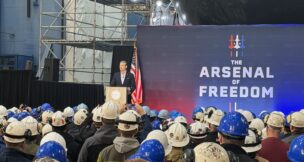Viral load
Port feels effect of coronavirus early but remains busy
Kate Andrews //April 30, 2020//
Like a canary in a coal mine, the Port of Virginia felt the impact of COVID-19 well before others in Virginia started to feel it. In February, the port saw a 9% drop in cargo compared with February 2019, a decrease attributed in part to the outbreak’s origins in China.
In 2018, China was the port’s top partner by value, passing $2.2 billion in exports and $11.7 billion in imports through Virginia’s terminals.
“China is one of our largest trading partners, both import and export, here in Virginia,” John Reinhart, executive director and CEO of the Virginia Port Authority, explained in February before the first COVID-19 cases were confirmed in Virginia. “It’s even larger in some other ports. I think impacts for us are going to be significant for a little while, but we believe that there may be a big return. Some of that demand is still going to be trying to catch up as soon as the [Chinese] plants are up and running and they’re able to export.”
At the time, Reinhart anticipated a drop in business at the port at least through the end of March, and possibly into May.
Without the virus, February should have marked a comeback for the port, because the United States government in January reached a resolution in its long tariff war with the Chinese government, a trade skirmish that affected many areas of the U.S. economy but particularly the nation’s ports both here and the West Coast.
But by February, China was in full lockdown, as coronavirus cases there numbered more than 80,000.
By the end of March, conditions had changed dramatically in Virginia as well. Gov. Ralph Northam declared a state of emergency and issued a stay-at-home order, closing the state’s schools and many nonessential businesses.
State universities moved classes online and postponed graduation ceremonies, and hundreds of thousands of Virginians were out of work or in danger of losing their businesses. The number of Virginia coronavirus cases jumped by as many as 100 patients a day just two weeks after the first case was recorded in the commonwealth.
The state’s secretary of finance anticipated a $1 billion hit to Virginia’s economy in a call to state lawmakers. Northam, in his daily news conferences in late March, emphasized “months, not weeks” before the state could return to anything approaching normal activity.
Critical cargo
But at the port, people are still at work. The Port of Virginia is considered an essential service by the state, explains Joe Harris, the port’s spokesperson.
“In my office, there are very few people,” Harris says, and “skeleton crews in other offices. At the terminals, where the heavy lifting is going on, it is very easy to maintain social distancing. Boarding agents have very limited contact with ship crews. We understand we have to provide this working environment.” The port has emergency sick leave and a short-term disability policy, in case of sickness or quarantine.
Much of the port’s work during the early spring involved preparations for a return to regular business, as well as continuing the dredging of Norfolk Harbor and the $375 million expansion of the Norfolk International Terminals, two long-term projects.
In late March, the port handled its first import load of COVID-19 testing kits and protective gear for health care workers, dispatching the container to Ohio within two hours of arrival. The port’s new Critical Cargo Initiative prioritizes shipments with test kits, medical equipment, hand sanitizer and other virus-related necessities. Working with ocean carriers and the International Longshoremen’s Association, the containers are quickly removed from vessels and picked up for delivery.
Cleaning and disinfecting, maintaining security, and operating vessels and terminals at normal capacity also were part of the workload.
Harris says the port anticipated an uptick in volume by May, as Chinese manufacturers had “just gone back to work” in late March, about a month after COVID-19 cases began to plateau in China. And it takes about 30 days for cargo to move from Chinese ports to Virginia, he notes.
“In general, coronavirus has impacted supply chains significantly as nations attempt to close borders [and] reduce air travel,” says Vinod Agarwal, an Old Dominion University economics professor who co-authors an annual economic forecast for the Hampton Roads region. The pandemic’s “impact on the real economy, especially in our nation,” Agarwal says, “is likely to be felt over the … months ahead.”
Hitting pause
Meanwhile, in other sectors of the maritime economy, the pause is affecting hiring and training programs. Huntington Ingalls Industries’ Newport News Shipbuilding had to place hiring on hold “until we are through this crisis,” says Vice President Herman Shelanski, a retired Navy vice admiral. NNS, which has more than 17,000 employees, is planning to hire about 2,500 people this year as it starts building nine or possibly 10 submarines in a $22.2 billion U.S. Navy contract it shares with General Dynamics Electric Boat.
In early April, 13 NNS employees had confirmed cases of COVID-19, prompting a full cleaning and disinfecting of two buildings.
“The safety and well-being of our workforce has been a top priority during this ongoing situation,” Shelanski says. “We are taking actions that are designed with the health and safety of our employees at the forefront of our decision-making. These include but are not limited to extending liberal leave [through the end of April], teleworking where feasible, alternate work schedules, etc. The company now allows cloth face coverings on-site and has expanded its liberal leave policy to include employees caring for a sick household member or a child home from school. The shipyard also has more handwashing stations and cleaning materials available.
While some workforce training courses continued virtually, others had to pause because the skills need to be practiced in person. The Apprentice School, which teaches full-time apprentices at NNS, suspended the second term of World Class Shipbuilding.
The Women in Skilled Careers program, operated by the Hampton Roads Workforce Council, trains women in welding, marine coating, electrical, pipefitting and other fields, but the courses were suspended in March.
Although the workforce council explored the idea of remote learning for the 18 students, it didn’t work “because of the lack of internet access and internet-capable devices,” said spokesperson Kelly Morro. “The closing of public sites such as libraries was also a factor. The plan is to continue the program as soon as they are able to ensure the health and safety of the participants.”
The port, say Harris and Reinhart, will see a return to regular business later this year as manufacturing picks back up. “But you have some businesses that [the coronavirus] could hurt for the long term,” Reinhart says. “It depends on their balance sheet. If they have some reserves and they can just weather the interruption in their business for a little while, or they even have business-interruption insurance that might cover some of it, they could get through OK.”

















